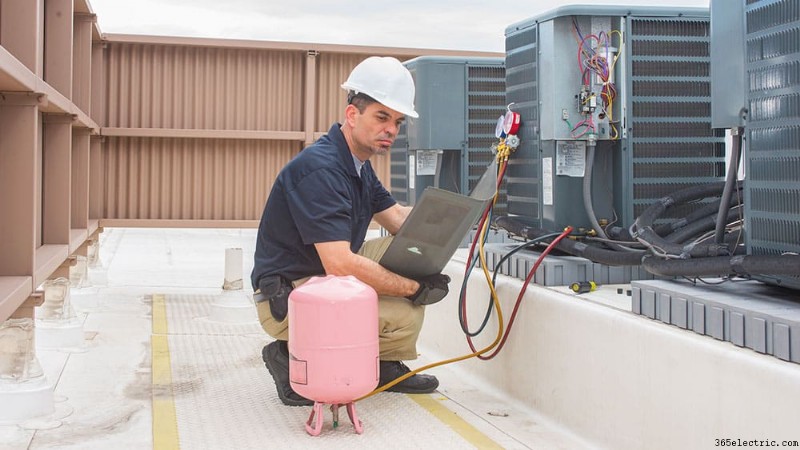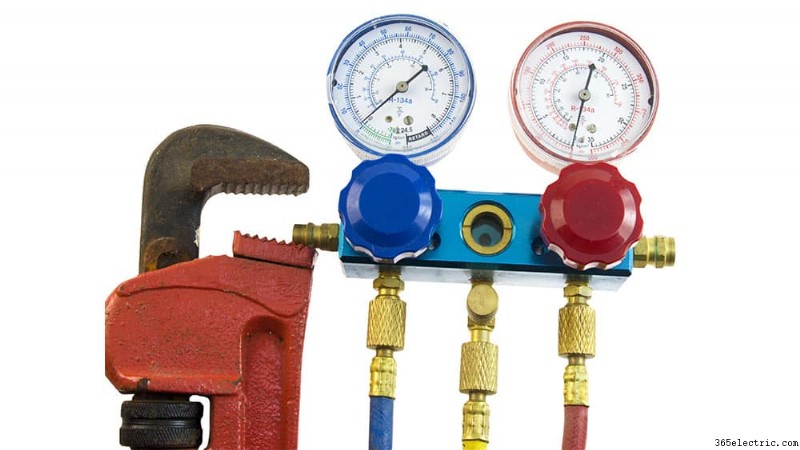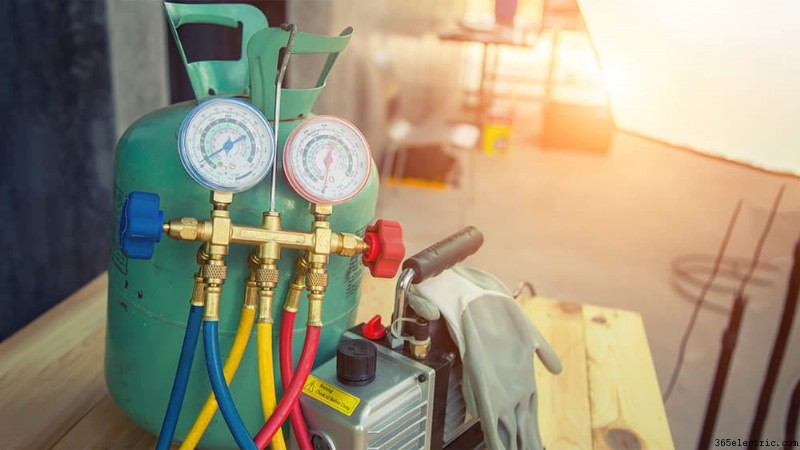Tutto quello che devi sapere sui refrigeranti AC e su come risolvere i problemi di refrigerazione

I refrigeranti AC sono la forza invisibile dietro il funzionamento del tuo condizionatore d'aria. La capacità del tuo condizionatore d'aria di raffreddare dipende da questo. I refrigeranti assorbono il calore e forniscono aria fresca mentre scorre attraverso il compressore e l'evaporatore.
La manutenzione HVAC richiede spesso la necessità di controllare il livello di refrigerante del sistema HVAC. Se il livello del refrigerante non è adeguato, il tuo sistema dovrà lavorare di più e non sarà in grado di raffreddare come desiderato.
Se dipendi dal tuo condizionatore d'aria o dalla pompa di calore, è bene rispolverare le tue conoscenze HVAC. Leggi e impara a conoscere i tuoi refrigeranti AC ed essere in grado di identificare e risolvere immediatamente eventuali problemi potenziali.
Cos'è un refrigerante AC?
Come avrai intuito, un refrigerante AC aiuta con la funzione di raffreddamento non solo del tuo condizionatore d'aria, ma anche di un frigorifero, congelatore o qualsiasi altro elettrodomestico che utilizza il raffreddamento.
Per saperne di più sulla funzione di un refrigerante AC, è importante sapere come funziona un condizionatore d'aria. Un condizionatore d'aria funziona utilizzando il refrigerante, che si trova all'interno delle serpentine di rame nell'evaporatore e nel condensatore, per assorbire il calore nella stanza ed espellerlo nell'ambiente esterno. Durante questo processo, il refrigerante passa da un gas a bassa pressione a un liquido ad alta pressione.
Questa è la spiegazione più semplice del ciclo di refrigerazione. Il liquido ad alta pressione soffia quindi con una ventola per espellere il calore nell'ambiente. Per iniziare il ciclo successivo, questo liquido si comprime ulteriormente, quindi viene espulso rapidamente da un ugello speciale per convertirlo nuovamente in gas. Questo gas freddo viene poi soffiato con un altro ventilatore per iniettare aria fredda nella stanza e il ciclo continua.
La storia dei refrigeranti AC
Il primo tentativo di un refrigerante AC risale al 1928, da parte di Thomas Midgley, Albert Henne e lo sforzo congiunto di Robert McNary. Hanno scoperto questi composti mentre lavoravano presso la divisione aria condizionata della General Motors. General Motors ha cercato di produrre un'alternativa non tossica e non infiammabile ad altri refrigeranti dell'epoca, come l'anidride solforosa o l'ammoniaca. I loro refrigeranti erano della classe dei clorofluorocarburi (CFC), conosciuti con il loro marchio, Freon.
Il refrigerante AC primario scoperto era l'R-22, un idrofluorocarburo (HCFC). Ha trovato un uso diffuso come refrigerante nei prossimi decenni come refrigerante preferito grazie alle sue proprietà favorevoli.
Alla fine degli anni '80, quando il mondo ha attirato la sua attenzione sui tassi crescenti del riscaldamento globale e di altri fattori ambientali, i CFC e gli HCFC sono stati sottoposti a un controllo più approfondito. Stavano danneggiando lo strato di ozono e sono stati banditi a causa dei loro effetti devastanti. Nel 1987 furono inseriti nell'elenco delle sostanze vietate del Protocollo di Montreal e gradualmente eliminate.
Tipi di refrigeranti AC
clorofluorocarburi (CFC)
La produzione di CFC, noti anche come Freon, è stata gradualmente eliminata nel 1995. Alcuni esempi di questi refrigeranti sono R11, R12 e R115. Sono stati ritenuti pericolosi per l'ambiente contribuendo all'esaurimento dello strato di ozono e all'effetto serra.
Refrigerante R22
L'R22 o Freon 22 è un refrigerante HCFC che è fondamentalmente un clorofluorocarburo ma con un atomo di idrogeno per ridurne la durata nell'ambiente. Dopo i CFC, sono diventati l'uso standard nei condizionatori d'aria dal 1960 fino a quando sono stati completamente eliminati essendo stati banditi per l'uso nei nuovi condizionatori d'aria nel 2010.
Se il tuo condizionatore d'aria è stato installato prima del 1 gennaio 2010, probabilmente utilizzava R22, mentre potresti essere stato in grado di ottenerlo a un costo crescente prima, è completamente cessato nel 2020.
R22 is also linked with environmental damage which is the reason behind its ban by the Environmental Protection Agency (EPA).
R410A Refrigerant
The ban on R22 necessitated the introduction of a new AC refrigerant R410A, also known as Puron. R-410A is a chlorine-free refrigerant making it much less harmful to the environment without losing its cooling characteristics.
It is essential to be careful since HVAC appliances intended for R-22 cannot be used with R-410A, considering its higher operating pressures.
Moreover, R-410A permits higher for an HVAC system, as compared to one using R-22 as well as better air quality and comfort. With higher SEER and lower power consumption there is an added benefit of lowering the total demand for power plants, thus reducing greenhouse emissions.
Replacing R-22 With R-410A
With R-410A being mandated by the government, the phase-out for R-22 has been a concern for many homeowners. If you already have an air conditioning system using R-22, worry not; you won’t have to throw it out.
The government protocols only concern manufacturers and bans them from making R-22 compatible air conditioners or R-22 itself after January 2020. You can keep on using your old air conditioner as it is. If there is a need to recharge it with refrigerant after 2020, your HVAC technician will have to source recycled R-22 for replenishment.
At the end of your old conditioner’s lifecycle and when the time comes to replace it, you will be restricted to only buying R-410A compatible air conditioners.
But it might just be better to make the switch early. R-410A is safer for the environment and gives you much greater energy efficiency as compared to R-22 thus reducing your energy bills.
Refrigerants are not the only way of saving energy, though. Read on about the 101 tips through which you can reduce your energy expenses.
R32 – The Future of Refrigerants
With time, refrigerants have been making progress, and now it is time for a new class of AC refrigerants, known as R-32. Il risultato? Lower energy consumption and even lower environmental impact. Let’s see how.
R-32 is the talk of the town these days, and for a good reason. For one, it has a Global Warming Potential (GWP) which is 32% that of R-410A. The GWP is a measure of how much emissions a chemical substance is contributing to the environment. A lower GWP means fewer emissions and more environmentally friendly refrigeration.
Moreover, systems that use R-32 consume up to 20% less refrigerant in the system, saving up on costs even further.
Even though there is still some time in the widespread adoption of R-32, the future is very bright for this class of refrigerants. With countries such as Japan and China already implementing it, it is only a matter of time before the world at large moves towards these higher efficiencies. In the US reports suggest half of window ACs sold in 2018 used R32.
Which Refrigerant Does My Air Conditioner Use?
If your air conditioning system was built before 2010, there is a high chance that your AC has R-22. But there’s an even more authentic way to find out. You can look at the appliance description sticker on the side of the air conditioner’s outdoor unit. The type of AC refrigerant is written there. You can find it on the user manual, or you can contact your HVAC service representative and find out!
How Do I Tell If My AC Refrigerant Needs Work?

Now that you have a brief background on refrigerants and what they do, it helps be aware of some of the . The refrigerant in an AC is not something that you should generally worry about. They are built to outlast your air conditioner. But in rare cases, there can be a leak of the refrigerant, and you would need to top it up. We’ll go over some of the common problems below:
- Cool Air Not Coming Out of AC Vents:
If your AC is in cool mode, but there is room temperature air being blown out, you need to look at your refrigerant. This is by far the most common problem. An AC refrigerant is required to provide cooling, and without a refrigerant, it would not be able to do so.
There can be other causes for such a problem too, but a sudden shift from cool air to room temperature air is a tell-tale sign that your AC refrigerant leaks.
- Frozen Coils:
If you take a glance within your ductless indoor unit, you will see a network of copper coils, dark gold in color. The refrigerant flows to provide cooling within these coils. These coils are very icy to touch, but they should not be having frost over them in regular operation. If you see signs of frost on the coils, there is a high chance that the refrigerant could be leaking.
- Scheduled Maintenance:
It is better to have , especially before the start of a busy season. For air conditioners, this is just before summers start. At this time, a good HVAC technician can spot an AC refrigerant leak, and propose remedial measures.
The cause of leaks can be various. It can be a manufacturing defect, which has surfaced after prolonged usage, or because of damage encountered during use.
What Is the Solution to an AC Refrigerant Leak?
AC refrigerant leaks can be worrying, but they are extremely common. Let’s look at how to solve this common issue and keep your air conditioner running in top shape.
Recharging Your Refrigerant

Recharging means to top up your air conditioner with more refrigerant. If your system is low on refrigerant, you won’t get enough cool air coming out of your vent. Thus, the recharge is imperative.
A recharge should only be done by a professional contractor, due to the high levels of pressure involved. Moreover, there is increased risk of damage to your air conditioner, which can result in an even higher bill.
Your professional contractor will also find out any major underlying problem, such as a much larger leak, or loose fittings. These can cause problems further down the road as well. He will fix any minor leaks or issues on the spot, and recharge your air conditioner with refrigerant. Your AC will be functional in no time again!
